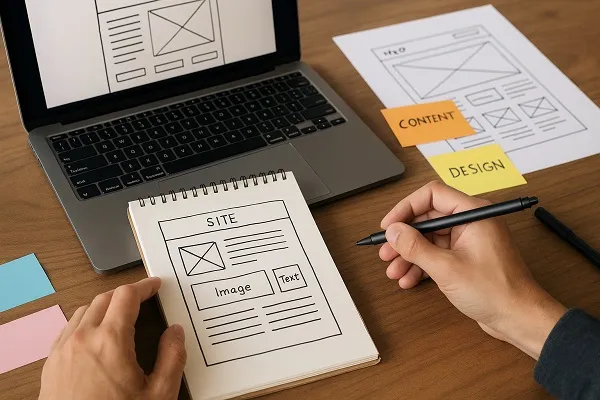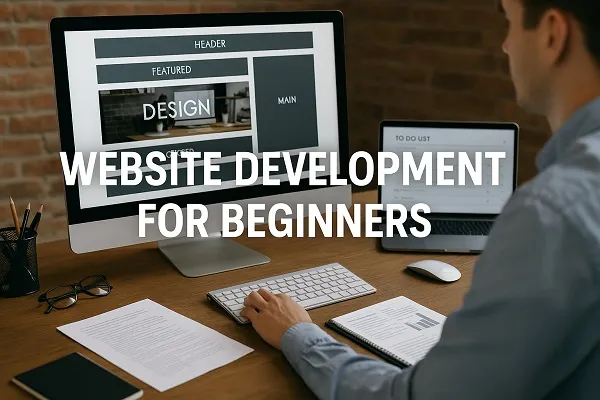Website development for beginners is an exciting opportunity to create an online presence that represents your goals, business, or personal brand. Whether you want to build a blog, portfolio, or e-commerce site, understanding the core aspects of website development helps you make better decisions and build with confidence. This guide will walk through the essential elements of getting started, from planning and design to functionality and optimization.
Getting Started with Website Development
Before you begin building, clarity is key. Identify what your website is meant to achieve. A well-planned structure saves time and ensures your design and content align with your goals.
Define Your Purpose and Audience
Ask yourself:
- What is the primary goal of the website? (e.g., sales, information, showcasing work)
- Who is the target audience?
- What action should visitors take?
Knowing these answers helps shape your website’s layout, design style, and content strategy.
Choosing the Right Platform

Selecting a platform is one of the most important decisions in website development for beginners. The right platform determines how easily you can build, update, and maintain your site.
Popular Options
- WordPress: Ideal for blogs, business sites, and online stores. Highly customizable.
- Wix: Great for beginners who want a drag-and-drop builder with built-in tools.
- Squarespace: Offers beautiful templates and strong design control.
- Shopify: Perfect for e-commerce websites with integrated payment options.
When choosing, consider scalability, budget, ease of use, and the type of content you’ll publish.
Essential Elements of a Website
Every effective website includes several key components that improve functionality and user experience.
Core Elements
- Navigation: Simple menus that help users find information easily.
- Header and Footer: Consistent sections that contain your logo, links, and contact information.
- Call-to-Action (CTA): Buttons or links that encourage visitors to engage.
- Responsive Design: Ensures your site looks great on phones, tablets, and desktops.
A well-balanced layout with these elements enhances user engagement and builds trust.
Designing for Usability and Aesthetics
A visually appealing website keeps visitors interested, while usability ensures they stay longer and interact more.
Design Best Practices
- Keep a clean and organized layout.
- Use readable fonts and complementary color palettes.
- Include plenty of white space to prevent clutter.
- Optimize images for faster loading times.
- Maintain consistent styling across all pages.
Your design should guide users naturally toward the most important content.
Developing the Structure and Content

The structure of your website influences how easily users and search engines navigate it. Organize your pages logically and write content that provides real value.
Content Organization
- Homepage: Introduce your purpose clearly.
- About Page: Share who you are and what sets you apart.
- Services or Products: Explain offerings with benefits and visuals.
- Blog: Publish helpful, keyword-rich content regularly.
- Contact Page: Include forms, maps, and social media links.
Creating SEO-friendly content with keywords like website development, web design for beginners, and building your first website helps your pages rank higher on search engines.
The Importance of Responsive and Mobile-Friendly Design
Most internet traffic now comes from mobile devices, making responsive design a necessity. A mobile-optimized website not only improves user experience but also boosts SEO rankings.
Tips for Mobile Optimization
- Use flexible layouts that adjust to screen size.
- Avoid pop-ups that cover content on mobile.
- Test pages on multiple devices regularly.
- Optimize loading times with compressed images.
Google prioritizes mobile-friendly websites, so this step is essential for better visibility.
Integrating Functionality and Interactivity
Beyond basic design, interactivity can make your site more engaging. Adding useful features enhances the visitor experience.
Common Functional Additions
- Contact Forms for user inquiries.
- Live Chat Support to improve customer service.
- Social Media Integration for broader reach.
- Newsletter Signup Forms to grow your audience.
- E-commerce Tools like product pages, shopping carts, and payment gateways.
Each feature should serve a clear purpose aligned with your goals.
Optimizing for Search Engines (SEO)

SEO is a crucial part of website development for beginners. Optimizing your site helps search engines understand your content and improves visibility in search results.
On-Page SEO Tips
- Include relevant keywords naturally in titles, headings, and paragraphs.
- Write unique meta descriptions for each page.
- Use internal linking to connect related content.
- Optimize image alt text with descriptive keywords.
- Create fast-loading pages by minimizing large files.
Technical SEO
- Use HTTPS for secure browsing.
- Submit an XML sitemap to Google Search Console.
- Ensure your site has clean, crawlable URLs.
- Fix broken links to improve user experience.
When SEO is done right, it drives consistent organic traffic without paid advertising.
Testing and Launching Your Website
Before launching, thorough testing ensures everything works properly across all browsers and devices.
Pre-Launch Checklist
- Test all links and buttons.
- Check for mobile responsiveness.
- Proofread all text for errors.
- Ensure forms and CTAs function correctly.
- Measure load times and fix delays.
Once satisfied, publish your website and share it on your social platforms to attract your first visitors.
Maintaining and Updating Your Website

Website development doesn’t stop after launch. Ongoing maintenance keeps your site secure, updated, and optimized for performance.
Maintenance Tasks
- Update plugins, themes, and software regularly.
- Backup your site data routinely.
- Monitor site speed and fix slow pages.
- Review analytics to track visitor behavior.
- Refresh content to stay relevant.
A well-maintained site builds trust and supports long-term growth.
Building a website as a beginner might feel overwhelming at first, but with consistent practice and a clear strategy, it becomes manageable and rewarding. By understanding design fundamentals, SEO strategies, and maintenance best practices, you can create a website that not only looks great but performs exceptionally well. Website development for beginners is a journey that leads to limitless opportunities for creativity, visibility, and success online.
Content reviewed and published by Parrot Branding Editorial Team.

